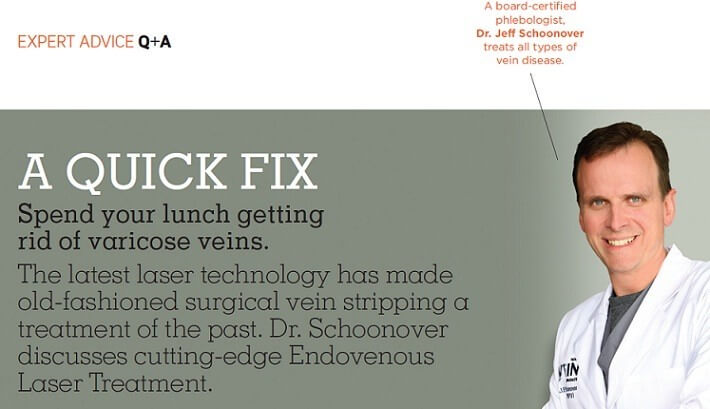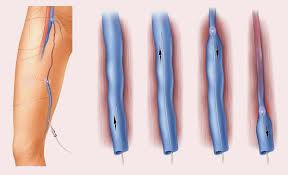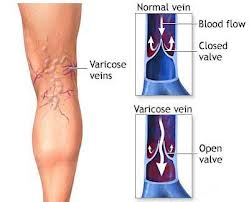News
After 40 Magazine: Endovenous Laser Treatment

Endovenous Laser Treatment

The following is a series of questions and answers between patients and Dr. Schoonover from After40 Magazine.
When my mom had varicose veins, she went to the hospital to have her veins stripped. I inherited her varicose veins. Will I need to undergo that operation?
Since the 1950s, surgical vein stripping has been the accepted treatment for varicose veins. However, thermal ablation technology, including Endovenous Laser Treatment (EVLT), has replaced this approach for the majority of patients with varicose vein disease. It is an FDA-approved alternative to stripping surgery, which requires no hospitalization, no general anesthetic, no scalpels and no extended time off work.
Exactly what is EVLT?
EVLT is a minimally invasive treatment for varicose veins. However, to help you understand the procedure, let me first explain what a varicose vein is.

Varicose veins are veins that have become enlarged and twisted. Usually they occur in the legs, although they can occur elsewhere in the body. All veins have valves that keep blood from flowing backward. The backward flow is called reflux.
Our circulatory system uses our leg muscles to pump the veins and send blood back to the heart. When veins become varicosed, the valves no longer work properly and allow the blood to flow backward, which enlarges the veins even more. Swelling, heaviness, tiredness, muscle cramps and even restless legs can be symptoms of varicose veins. As varicose veins progress, chronic skin inflammation and breakdown (ulceration) can occur. Varicose veins are often painful, so it is important to treat them in order to maintain an active lifestyle.
Prior to the EVLT procedure, we perform an ultrasound that identifies the veins that are the source of the reflux. Using EVLT, guided by ultrasound, we insert a small laser fiber through the skin into the varicose vein. Laser energy is delivered inside the vein, which causes the vein to collapse and seal shut. Once that vein is closed, the blood reroutes to other healthy veins.
This procedure is done in our office under local anesthetic. It usually takes 30 to 45 minutes. Following the procedure, patients will wear a compression stocking on the treated leg. Most patients return to work within a day or two. In fact, many of our patients return to work the same day. Any post-procedure pain can be nicely managed with anti-inflammatory drugs such as ibuprofen or naproxen. At our office, we are using one of the newest wavelength laser systems that significantly reduces post-procedure bruising and discomfort.
Is the treatment permanent or will the varicose veins come back?
One of the major advantages of EVLT is that the recurrence rate is less than what you’d get with surgical stripping. Some reports show a surgical stripping recurrence rate as high as 20 to 30 percent. The reported recurrence rate of EVLT is approximately 5 to 8 percent after five years. We have seen excellent long-term results with EVLT.
Are there any other advantages to EVLT?
The use of local anesthetic is significant and allows EVLT to be done in the office/outpatient setting. Anytime one receives a general or spinal anesthetic, such as in vein stripping surgery, there is a risk factor. EVLT eliminates that risk. Secondly, unlike with surgical stripping, there are no stitches or staples. The third advantage is minimal time off work. People who have surgical stripping usually require at least a week off work.
Will I need any other treatment?
Depending upon your situation, you may also need sclerotherapy to treat additional refluxing branch veins as well as surface “spider” veins. The number of treatments needed will vary depending upon the patient and the severity of these veins. Most of the veins respond during the first treatment and will continue to improve over time, but additional treatments may be needed.
